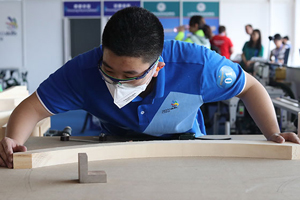Scientist saves workers' eyes, cuts factory costs
In a giant, dark factory, thousands of?young people?sat in separate booths, each staring through a small glass rectangles at a bright white lamp on their tables looking for defects.
Each had a pile of the smartphone screens at their side, as well as several large bottles of eye drops, which they used every few minutes.
Zhang Zhengtao, 36, a scientist and Party representative from the Chinese Academy of Sciences' Institute of Automation, witnessed the scene at a quality inspection factory for smartphone screens in Dongguan, Guangdong province, two years ago.
|
|
|
Zhang Zhengtao |
"I tried the work once, and my eyes got sore within a minute," he said. "It broke my heart seeing those young people doing such eye-scorching work, day after day for months, sacrificing their eyesight just so that we can have the latest phones."
Zhang specializes in precision measurement and equipment assembly, which involves measuring, controlling or making extremely small equipment often in the scale of a millionth or even a billionth of a meter.
Most of his work is used in national cutting-edge science projects, from spacecraft to nuclear energy, where accuracy is paramount. After seeing the factory, Zhang wondered if he could apply his skills to replace manual inspection with robotics.
"As a Party member, I have a duty to use what I have learned to help industry and its workers," he said.
But the problem was far more complicated than Zhang thought. "Most people thought producing phone screens was simple, so it could be done entirely by robots," Zhang said.
Though it's true that computers do most of the production work, machines don't have the thinking ability needed to detect the two dozen types of small defects, from cracks to dust to fingerprints, he said.
"Tiny defects from previous production procedures and can be pressed together with other defects, creating an illegible mess for computer scanners," Zhang said.
And computers have difficulty distinguishing between defects that are easily resolved, like dust or fingerprints, from serious ones like cracks or nicks, "because to a computer camera, they look very similar," he said.
Experienced workers can recognize complicated defects when they examine the glass screen under bright light, but they typically misjudge more than 5 percent of the products. Given the rising demand and tight working schedules, companies have no choice but to invest heavily in manual inspection, he said.
Last year, China produced about 2.1 billion phone screens and employed more than 150,000 inspectors. Manufactures spend more than 10 billion yuan ($1.5 billion) a year on personnel, from salary to insurance, Zhang said.
"If we can replace manpower with machine, not only can we decrease the fault rate and cut cost by hundreds of millions, we can also keep of young adults from damaging their eyes," he said.
But creating a machine smart enough to detect various defects after the screen is finished is still too hard, Zhang said. So he decided to take it one step at a time, and in 2016, his team created China's first fully automated optical inspection machine for glass printing, a key step in making phone screens.
AOIs are most commonly used in checking for defects in printed circuit board. "It is essentially a highly sensitive camera that rapidly scans the object and then identify various types of defects using its vast database," he said, adding that Germany is leading the world in AOI technology, but they seldom apply AOI in cover glass production.
By focusing on defects found in a single manufacture step, Zhang was able to apply machine learning and artificial intelligence to analysis of a massive quantity of data, creating a "visual recognition database that can read glass printing defects like a human mind," he said.
This new machine has less than a 1 percent error rate for identifying defects. Since glass printing is an early production procedure, the machine reduces the workload and difficulties of quality inspection in the final stage, he said.
During testing, a single machine can help a factory save more than 650,000 yuan annually on glass printing defects alone, Zhang said. The machine has recently passed all testing and is available for industrial use.
"We will build similar 'AI+AOI' machines in the future and apply them to other phases of the phone screen production line, such as plain glass inspection, and possibly even branch out to other industries like electronics or energies," Zhang said.




























